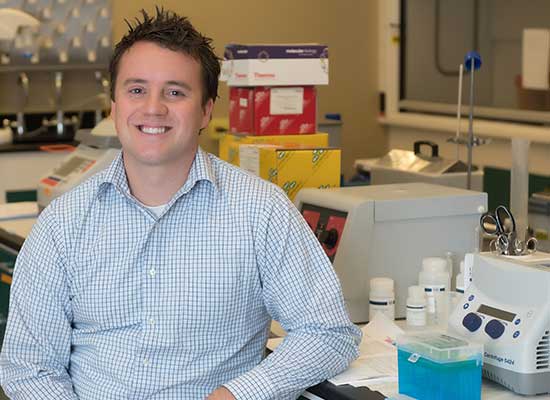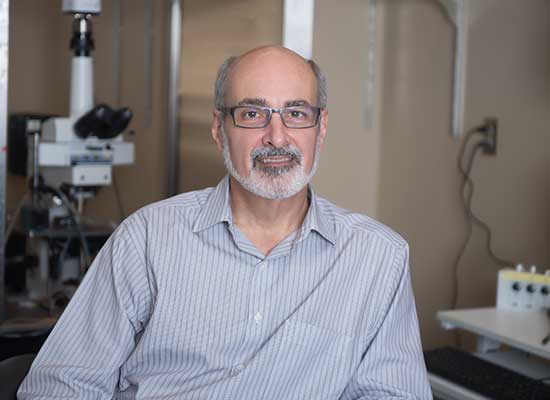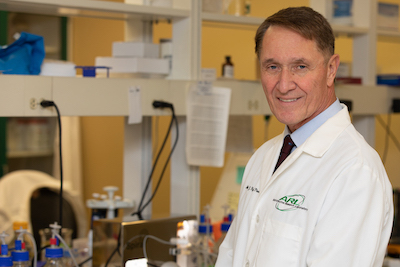Research Scholars faculty mentors
How to apply Projects and publications Research Scholars home
| Faculty mentors for the cohort admitted 2022 | |
|---|---|
Mel BediAs a dual PharmD, PhD professional, I aspire to engage in translational research projects to offer a bench-to-bedside approach to patient care. My main interest is in the design and synthesis of site-specifically modified nucleic acid analogs. Nucleic acids are important biomolecules that carry the genetic information of organisms from one generation to the next. As such they represent an attractive area of study with many applications including:
|  |
Kyle BurghardtThe Burghardt lab's primary research seeks to understand the molecular mechanisms that are responsible for the development of insulin resistance and diabetes secondary to atypical antipsychotic treatment. The lab performs DNA methylation analyses by pyrosequencing, array and next-generation sequencing. Collaborative efforts in the lab aim to measure DNA methylation in various projects related to other disease states such as PTSD, skeletal muscle health, exercise capacity and diabetes. The lab also regularly performs meta-analyses on literature topics to our research interests. | |
Randy CommissarisDr. Randall Commissaris (Pharmaceutical Sciences) uses driving simulators to study distracted driving and the effects of drugs (alcohol, marijuana, OTC, Rx meds) on driving performance. His laboratory includes a fixed-base driving simulator within the EACPHS building; this is a full-sized car (Chevy Impala) that is equipped with video projections and four computers for the assessment of multiple driving performance measures under varying driving conditions. Dr. Commissaris' laboratory also uses a Virtual Reality (VR)-based driving simulator with a 'gaming chair' to study the effects of distractions and drugs on crash avoidance reaction times. This VR-based driving simulator is portable and, in a post-COVID world, it can be taken to off-campus sites for public, hands-on "don't drink and drive" community service presentations illustrating the actual effects of alcohol and marijuana on driving performance. Recent publications:
|  |
Christopher GiulianoDr. Giuliano's research centers on his practice as an internal medicine specialist. He has been involved with a variety of study designs including randomized controlled trials, cohort studies, qualitative studies, mixed method research, quasi-experimental studies, and meta-analyses. In addition to publications he has obtained federal and national grant funding. His past research scholar projects are as follows:
| |
| Faculty mentors for previous cohorts | |
|---|---|
David Pitts, program coordinatorThe research of Dr. Pitts focuses on environmental toxicology with an emphasis on the impacts of chemical pollution on water quality. Many xenobiotics find their way into surface water and ground water via wastewater effluent from treatment plants or from runoff from urban or agricultural areas. Many of the chemical contaminants are not typically monitored or regulated, and are deemed contaminants of emerging concern (CECs; USGS Toxic Substances Hydrology Program) because of their potential impact on environmental health and human health. The CECs include pharmaceuticals and other organic contaminants that can produce toxic effects either as individual agents or by their contribution to toxic mixtures (mixture toxicology). Some of the CECs may disrupt endocrine function and have been termed endocrine disrupting chemicals (EDCs). We use unique assay systems designed for aquatic animals (Waterfleas - Daphnia pulex and zebrafish - Danio rerio) to evaluate the sub-lethal toxic effects of CECs on behavior and to determine how chemical exposure affects gene expression. Since worldwide feminization of aquatic vertebrates such as fish has been observed, one research project focuses on the development of a molecular identification model capable of detecting estrogenic and/or anti-androgenic activity in water samples.1 A second research project utilizes modified versions of these bioassay systems to evaluate the toxic effects of volatile organic chemical (VOC) exposure. Detroit has been reported to have an elevated pre-term birth rate, and it has been reported by Cassidy-Bushrow et al.2 (2020) that this may in part result from exposure to a mixture of petroleum related chemicals referred to as BTEX (benzene, toluene, ethylbenzene, and xylene). BTEX contaminated soil can be mobilized by ground water and can cause exposure in homes and buildings via vapor intrusion. This project examines the toxic effects of BTEX mixtures by determining the toxicity of individual constituents and mixtures of constituents using specific mathematical models (e.g., concentration-addition, independent-action). 1Alla et al. (2021) Detection of endocrine disrupting chemicals in Danio rerio and Daphnia pulex: Step-one, behavioral screen. Chemosphere 271: 129442. 2Cassidy-Bushrow et al. (2020) Prenatal airshed pollutants and preterm birth in an observational birth cohort study in Detroit, Michigan, USA. Environmental Research 189: 109845. | |
Andrew BertiThe Berti Lab investigates how combining antibiotics in a deliberate and rational manner can improve outcomes for patients with challenging bacterial infections. We integrate pharmacokinetics, bacteriology, molecular biology, metabolism, and recombinant genetics to examine when combination therapy is appropriate, why combination therapy can provide benefit and how best to administer antibiotic combinations. We have active projects involving the human pathogen Staphylococcus aureus that examine combination antimicrobial therapy, mechanisms of antimicrobial resistance, mechanisms of antimicrobial tolerance, and optimization of pharmacological interventions. |  |
Navnath GavandeDr. Gavande has extensive experience working at the interface of chemistry and biology. Dr. Gavande worked as a postdoctoral fellow with Prof. John Turchi at Indiana University School of Medicine and also with distinguished Prof. Arun K. Ghosh at Purdue University before joining Wayne State University College of Pharmacy and Health Sciences. The Ghosh laboratory has created Darunavir (Prezista®), an FDA-approved first drug treatment of drug-resistant HIV for HIV/AIDS patients. The research program of the Gavande laboratory is focused on the design and development of molecular target-specific novel small molecule drugs for the treatment of cancer, viral and bacterial diseases. We also develop and utilize new computational and informatics methods and tools for drug design and discovery. In collaboration with Dr. Arun Iyer's laboratory, we are developing targeted liposomes, polymer and nanoparticle drug delivery system for cancer and antibiotic-resistant superbugs with the highest goal of translating the technology in clinic. The two classes of targets that we are particularly interested in are protein-protein and protein-DNA interactions. As such, both academia and the pharma industry initially largely ignored exploring these targets and deemed them as "undruggable." However, recent advances in these fields indicate that protein-protein and protein-DNA interactions can be validated targets for the development of cancer therapeutics and other diseases. The Gavande laboratory is working toward validating undruggable targets in cancer through an interdisciplinary chemical biology approach. | |
Linda JaberDr. Linda A. Jaber is a tenured professor of pharmacy practice at Wayne State University. Dr. Jaber is extensively involved in the field of clinical diabetes research. Her research program focused on determining response differences to chronic hypoglycemic agents in patients with type 2 diabetes. This research evaluated the effects of chronic dosing, age, and obesity on the pharmacokinetics and pharmacodynamics of hypoglycemic agents. She has received the National American Diabetes Association Clinical Research Award to study the epidemiology and risk factors of diabetes, pre-diabetes and the metabolic syndrome in the Arab American population. Her research led to the characterization of the metabolic defects underlying the progression to diabetes, the association between Vitamin D and Insulin resistance, and exploring the racial differences in sensitivity and specificity of glycated hemoglobin in identifying diabetes and pre-diabetes in this population. She has also received NIH funding to examine the feasibility of diabetes prevention in Arab Americans and to explore the barriers and facilitators to adopting diabetes prevention. | |
Anjan KowluruDiabetes is a serious medical condition resulting from failure of insulin action and/or insufficient insulin secretion from the pancreatic β-cells. The International Diabetes Federation estimates that there will be 578 million adults with diabetes by 2030, and 700 million by 2045. The National Diabetes Statistics Report indicates that 34.2 million Americans (1 in 10) have diabetes. Alarmingly, 88 million American adults (1 in 3) have prediabetes. Therefore, efforts to understand the pathophysiology of this disease are highly relevant to future developments in care and therapeutics of this disease. Dr. Anjan Kowluru's research team is actively involved in addressing key questions relating to the onset of diabetes. His research is focused on understanding the roles of small G-proteins in glucose-induced secretory granule transport for fusion and exocytosis of insulin. Further, his team is actively investigating potential abnormalities in these signaling pathways in islets derived from type 2 diabetes human donors and animal models. Of immediate clinical relevance are recent findings from Dr. Kowluru's laboratory suggesting that pharmacological and molecular biological inhibition of specific signaling modules largely restores metabolic defects in the islet preparations from diabetic human donors. | |
Michael J. RybakMichael J. Rybak, Pharm.D., M.P.H., PH.D., is Professor of Pharmacy, Department of Pharmacy Practice, Director, Anti-Infective Research Laboratory, Eugene Applebaum College of Pharmacy & Health Sciences, Wayne State University. He is also adjunct Professor of Medicine, Division of Infectious Diseases, School of Medicine at Wayne State University. He is affiliated with the Detroit Medical Center and is a member of their antimicrobial stewardship committee. Dr. Rybak's research focus is antimicrobial pharmacokinetics and pharmacodynamics (PK/PD) and the assessment of infectious diseases health outcomes including their relationship to bacterial resistance. Dr. Rybak is funded by the National Institute for Allergy and Infectious Diseases (NIAID) and via several investigator initiated grants from Pharmaceutical Industry. He has published more than 400 manuscripts and authored more than 20 book chapters on antimicrobial PK/PD, resistance and antimicrobial stewardship. He is the editor-in-chief of the journal Infectious Diseases and Therapy, scientific editor for Infectious Diseases for the journal Pharmacotherapy, editorial board member for Critical Reviews in Microbiology, the journal Antibiotics and for Contagion. | |
Michael VeveMichael Veve, PharmD, MPH is a clinical assistant professor of pharmacy practice at WSU Applebaum and an infectious diseases pharmacist at Henry Ford Health System–Detroit. Dr. Veve's training background includes a fellowship in infectious diseases and antimicrobial stewardship outcomes research. His research priorities include developing and implementing innovative antimicrobial stewardship interventions that improve patient care at Henry Ford Health System, with an emphasis in ambulatory care settings. He also prioritizes public health outcomes research involving access to care in underserved populations. The general focus of his research includes the burden of illness and epidemiology of resistant pathogens, antimicrobial optimization in critically ill and immunocompromised populations, and evaluating opportunities to improve outcomes in people who inject drugs (PWID) with associated infections. These research opportunities are often multidisciplinary in nature and would allow prospective students to develop the essential skill of interpreting clinical data and learning how to apply these data to current practice. | |








 Susan Davis
Susan Davis